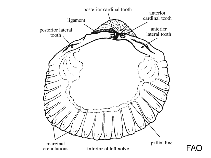Keenocardium californiense (Deshayes, 1839)
Aleutian cockleGoogle image | No image available for this species;
drawing shows typical species in Cardiidae.
Classification / Names Common names | Synonyms | CoL | ITIS | WoRMS
Bivalvia | Cardiida | Cardiidae
Environment: milieu / climate zone / depth range / distribution range Ecology
Benthic; depth range 10 - 100 m (Ref. 95344). Temperate
Distribution Countries | FAO areas | Ecosystems | Occurrences | Introductions
Eastern Pacific and the Arctic: Alaska and Canada. Temperate to polar.
Length at first maturity / Size / Weight / Age
Maturity: Lm ? range ? - ? cm Max length : 7.5 cm SHH male/unsexed; (Ref. 95344)
Life cycle and mating behavior Maturity | Reproduction | Spawning | Eggs | Fecundity | Larvae
Main reference
References | Coordinator | Collaborators
Lamb, A., D. Gibbs and C. Gibbs 2011 Strait of Georgia biodiversity in relation to bull kelp abundance. Pacific Fisheries Resource Conservation Council, 111p. (Ref. 93817)
IUCN Red List Status
(Ref. 130435: Version 2025-1)
CITES status (Ref. 108899)
CMS (Ref. 116361)
Threat to humans
Human uses
| FishSource |
Tools
More information
Diet composition
Food consumption
Predators
Max. ages / sizes
Length-weight rel.
Length-length rel.
Length-frequencies
Mass conversion
Abundance
Internet sources
BHL | BOLD Systems | CISTI | DiscoverLife | FAO(Publication : search) | Fishipedia | GenBank (genome, nucleotide) | GloBI | Gomexsi | Google Books | Google Scholar | Google | PubMed | Tree of Life | Wikipedia (Go, Search) | Zoological Record



